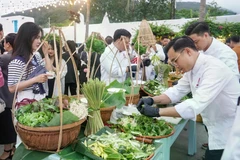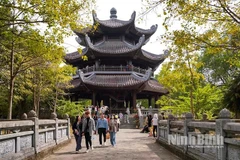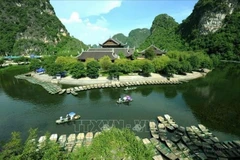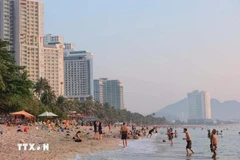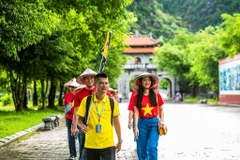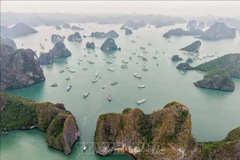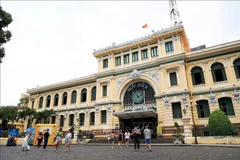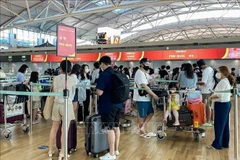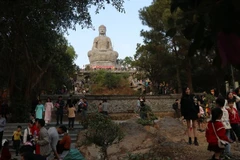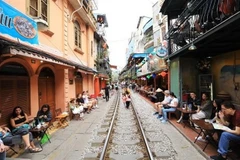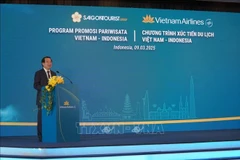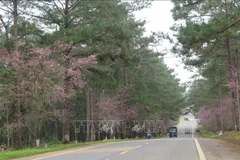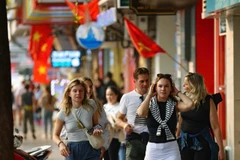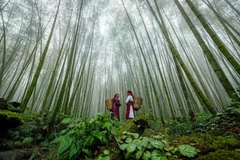HCM City (VNA) - In recent years, wedding tourism has emerged as a growing contributor to local economies in several regions across Vietnam. Recognising market demand, authorities and businesses are encouraged to invest in developing this tourism segment to boost revenue while promoting destinations, especially to international travellers.
Rising market trend
Vietnam's tourism sector aims to welcome 22-23 million international arrivals and 120-130 million domestic travellers by 2025. Achieving this target requires tapping into new trends and visitor segments. Wedding tourism, although still relatively new, presents significant potential for the country's tourism economy.
According to Nguyen Quang Vinh, an expert from the Institute for Tourism Development Research, wedding tourism has become a strategic focus for many Asian countries, particularly in Southeast Asia. Nations like Thailand, Indonesia and Vietnam have capitalised on their tropical beaches, vibrant cultural values and affordable event costs to attract couples seeking memorable wedding experiences.
Wedding tourism, a concept where couples travel to a destination to host or attend wedding ceremonies and related events such as proposals, engagements, pre-wedding photoshoots, honeymoons, or anniversary celebrations, is emerging as a lucrative niche in the travel industry.
Vietnam, with its picturesque landscapes, pristine beaches, luxurious resorts, and affordable yet high-quality services, holds great potential for developing this sector. The country's diverse settings provide a variety of backdrops for weddings, ensuring each ceremony offers a unique ambiance and décor.
Vinh said several destinations in Vietnam have strong potential for wedding tourism growth. Popular hotspots such as Phu Quoc, Da Nang, Phan Thiet, Ninh Binh, and Quang Ninh are favoured not only for their natural beauty and premium hospitality services but also for the immersive experiences they offer.
While still a relatively new concept in Vietnam, wedding tourism has the potential to deliver significant economic benefits. Wedding celebrations often involve hundreds of guests, many of whom extend their stays to explore the destination, boosting demand for accommodations, dining, shopping, and local experiences. Furthermore, when wedding guests share their photos and experiences online, they inadvertently promote Vietnam’s culture, people, and scenic beauty to a global audience.
In recent years, popular destinations such as Phan Thiet (Binh Thuan province), Con Dao island (Ba Ria - Vung Tau province), Phu Quoc island (Kien Giang province), and Ha Long (Quang Ninh province) have hosted numerous wedding events, reflecting growing interest in this market. These trends underscore Vietnam’s rich potential to become a preferred wedding tourism destination, thanks to its pristine beaches, cultural heritage sites, upscale resorts, vibrant cuisine, and warm hospitality.
For instance, in 2019, an Indian billionaire couple chose Phu Quoc as their wedding venue, hosting 700 guests in a grand celebration. Since then, Phu Quoc’s luxury resorts have continued to attract international couples seeking memorable wedding experiences. The island's consistent recognition at prestigious global tourism awards further solidifies its position as a top-tier wedding destination.
Boosting wedding tourism market
To further develop this promising market, experts suggest local authorities and tourism stakeholders should adopt tailored strategies. Understanding the preferences of international couples, such as beachside weddings in Phu Quoc, Da Nang, or Ha Long, or traditional-themed ceremonies in cultural hubs like Hoi An and Hue, will help shape attractive wedding tourism packages.
Moreover, businesses must account for cultural differences in wedding traditions to create personalised, unforgettable experiences for international couples. Expanding promotional efforts through social media and showcasing successful destination weddings in Vietnam will also enhance the country's appeal to foreign markets.
Equally important is investing in skilled personnel specialising in wedding services. Training in event planning, decoration, photography, videography, and fashion styling will elevate service quality, ensuring Vietnam's wedding tourism industry thrives.
From a business perspective, Dinh Duc Quang of APEC Mandala Wyndham Mui Ne said wedding tourists are often affluent, willing to spend generously on premium services. Their extended guest lists create additional demand for hospitality services, providing an excellent opportunity for tourism businesses to boost revenue. By offering attractive experiences to encourage extended stays, destinations can further capitalise on this lucrative market.
Tran Thi Mai Huong, an expert from the Vietnam National Authority of Tourism, highlighted the need to cater to the personalised nature of wedding tourism. Couples often seek distinctive elements such as unique venues, creative décor, and tailored activities. With guests frequently traveling from multiple countries, service providers must design memorable experiences that resonate with diverse cultural backgrounds, Huong noted./.






